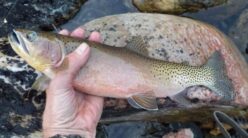BLACKFOOT — Though temperatures in Southeast Idaho have climaxed in the high 90s the past few weeks, recreational swimmers, especially those enjoying Jensen’s Grove in Blackfoot, are feeling the effects of a long, harsh winter.
Several visitors to Jensen’s Grove have reported cases of swimmer’s itch and many posted pictures of their infection to social media sites.
Meanwhile, Blackfoot Mayor Paul Loomis said he is unaware if more cases have been reported this year than in years prior, but he offered an explanation as to why swimmers may be more susceptible this time of year.
“There was a two-week period around the end of June that the Snake River was so high that we closed the inlet (to Jensen’s Grove) entirely,” Loomis said. “The river was so high that it was backing in from the outlet.”
Now, Loomis said city officials are running a considerable amount of water, about 30 cubic feet per second into Jensen’s Grove to help mitigate swimmer’s itch complaints.
Swimmer’s itch, also known as cercarial dermatitis, appears as a skin rash. It’s caused by an allergic reaction to certain microscopic parasites that infect some birds and mammals, according to the Centers for Disease Control and Prevention’s website.
These parasites are released from infected snails into areas with fresh and salt water such as lakes, ponds, and oceans. While the parasite’s preferred host is the specific bird or mammal, if the parasite comes into contact with a swimmer, it burrows into the skin causing an allergic reaction and rash. Swimmer’s itch is found throughout the world and is more frequent during summer months.
Symptoms — which include tingling, burning or itching skin, small reddish pimples and small blisters — can be treated with corticosteroid cream, a cool compress, a baking soda, Epsom salt or colloidal oatmeal bath, anti-itch lotion or a paste made from baking soda and water, according to CDC’s website. Typically, those who contract the rash don’t have to seek medical attention.
Steve Pew, the environmental health director for Southeastern Idaho Public Health, said swimmer’s itch isn’t something local health experts track and report on in terms of other diseases.
“We don’t regularly track it, but I have heard of people contracting swimmer’s itch in some other bodies of water such as some smaller swimming areas that don’t have a larger circulation,” Pew said. “We have this every year almost like clockwork. We either recommend staying out of the water or be sure to shower off afterwards.”
Following several reports of swimmer’s itch at Jensen’s Grove, the city of Blackfoot released the following statement to its Facebook page last week:
“Please realize that swimmer’s itch occurs in any slow moving body of water that is frequented by water fowl. With the Snake River as high as it was, a high flow rate of water circulation wasn’t possible. Now that the Snake River is lower, we are circulating water through Jensen’s Grove as rapidly as possible to help reduce the problem of swimmer’s itch,” it said.
The statement notes there are signs posted at the Grove warning that individuals might get swimmer’s itch. The signs recommend rinsing immediately after getting out of the water. This will reduce, or eliminate entirely, the chances of getting swimmer’s itch.
Loomis said that in addition to posting additional warning signs, the city is considering adding warning messages in Spanish to accommodate bilingual or Spanish-speaking patrons.
“Some people just seem to be more susceptible to swimmer’s itch,” Loomis said. “Me and my grandchildren were out at Jensen’s Grove and we didn’t have any significant skin reaction. My recommendation is for those enjoying the water to shower immediately after they finish swimming in the water.”



